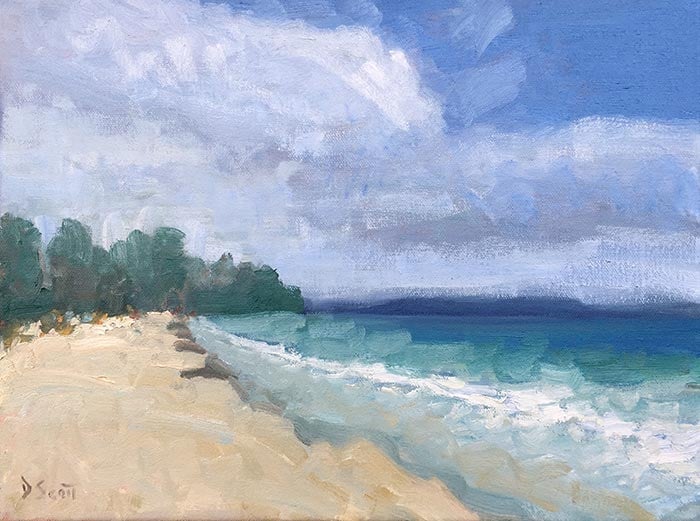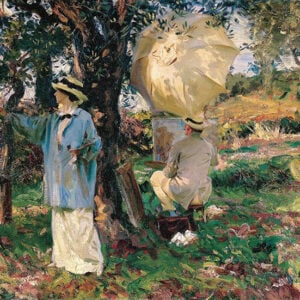This is a comprehensive guide on the idea of movement in art and how we can convey it in our artworks. I’ll cover:
- What Does “Movement” Mean in Art?
- How to Capture Movement in Art
- Other Examples of Movement in Art
- Additional Readings
- Thanks for Reading!
What Does “Movement” Mean in Art?
Our paints cannot physically move, but we can paint in a way that gives the illusion or suggestion of movement. This typically involves arranging shapes in a way that leads the viewer from one point to the next in your painting or using certain techniques with your brush to mimic the movement.
Perhaps the best example of movement in art (or at least the most famous) is Vincent van Gogh’s The Starry Night, which takes your eyes on a rollercoaster around all the twists and swirls.

How to Capture Movement in Art
Below are some of the techniques you can use to convey the idea of movement.
Suggestive Brushwork
A simple but effective method for capturing movement in your art is to use suggestive brushwork which mimics the general movement and gesture.
In Claude Monet’s painting below, his rough and energetic strokes match the nature of the water. Sweeping strokes capture the general ebbs and flows, whilst thick dabs of white and gray capture the whitewater.

You can almost feel the crashing waves on the rocks in Joaquín Sorolla’s painting below. Thick paint and bold strokes pull your attention around the painting as the water crashes between the rocks.

Part of painting in this way requires you to relax your decision-making and paint with instinct. It can be difficult to use suggestive brushwork without really getting a feel for the movement.
Broken Color
Broken color is a technique that involves painting with small dabs of distinct colors. It is particularly effective for depicting a sense of movement, as your eyes tend to jump between all the different colors—like a vibration of color.
You could even combine the broken color with suggestive brushwork, following the general movement and gesture. Joaquín Sorolla did that in his painting below; notice all the different tones of blue, green, yellow, white, and purple and how his brushwork follows the flow of the water. Also, notice how the rocks in shadow start to blend in with the shallow water as the colors overlap.

Childe Hassam also made effective use of broken color to depict movement in his seascapes. There is a beautiful contrast between the rich oranges and the deep blues and greens. Also, notice how his brushwork flattens out and becomes more solid as you get further into the distance; this creates depth and makes the foreground appear choppy by comparison.

Thick Versus Thin Texture
If you are trying to capture the movement of water, it can be effective to contrast thick texture for rough, turbulent areas against thin texture for calm areas. I did that to some extent in the painting below; thick, white paint was used for the crashing whitewash, whilst smooth and solid paint was used for the calmer areas.

Rhythm
Art can have a visual rhythm, much like the rhythm of music. But instead of notes and sounds, we use lines, colors, and shapes. A strong rhythm can pull your eyes around the painting as your eyes jump from one element to the next. For example, in Lofoten Island below, the contours of the water form repetitive triangular shapes which get bigger or smaller as the water ebbs and flows. These shapes create a sense of rhythm and movement.

I did a similar thing in my painting below, using the repetitive contours of the water to create a sense of rhythm, reinforced with suggestive lines over the top.

Using Line to Reiterate the Movement
You can use line to reiterate and strengthen the sense of movement in your painting. Monet did that with upward blue lines which suggest the contours and movement of the water.

Van Gogh’s entire painting below is constructed with nothing but short lines which lead you through and around the painting. The bright yellow sun appears to radiate with the lines circling around it.

Use of Scumbling
Scumbling is a technique that involves using a dry brush to apply broken color over a surface. Typically, light colors are scumbled across a dark foundation. The result can be an ethereal appearance which is perfect for painting atmospheric effects and movement.
Joseph William Turner used scumbling to great success in his atmospheric paintings. His Snow Storm below features multiple layers of grays, blues, greens, and white scumbled on top of each other.

Other Examples of Movement in Art
Below is a dramatic seascape by Winslow Homer. There are several elements that contribute to the sense of movement in the painting:
- The increased contrast and turbulence in the foreground compared to the background;
- The snaking lines in the water which follow the contours;
- The patterns created by the repetitive shapes; and
- The thick paint used for the crashing whitewater.

Below is a sketch by Leonardo da Vinci exploring the movement of water.

In Monet’s The Rue Montorguel in Paris, there is a sense of movement from the vast numbers of people combined with the simplified brushwork.

You can really feel the strong gust of wind in the painting below, with the tree branches being pulled to the left of the painting. Also, notice how the brushwork used for the grass and plants on the ground also leans towards the left. Subtle touches like this can make a significant difference; think about what the painting would look like if the brushwork for the ground was actually leaning toward the right.

Below is a stunning painting by Abram Arkhipov. I draw your attention to the smoke in the background. Arkhipov did a great job of painting the ethereal nature of the smoke whilst still using thick paint.

Additional Readings
Thanks for Reading!
Thanks for taking the time to read this post. I appreciate it! Feel free to share with friends. If you want more painting tips, check out my Painting Academy course.
Happy painting!

Dan Scott
Draw Paint Academy







Great stuff Dan. I especially like seeing thick rich painterly artists.
Thank u so much this was exactly what I was looking for u helped me more than the other 200 sites I went on with the same question….I look forward to learning more from u.
Hey great examples!
Can you email me these pictures?
Hi Vi
You should be able to save them directly to your device by right clicking to save (if on desktop) or holding down over the image to bring up the options (if on phone).
Thanks!
I really enjoyed reading this simplified yet completely understandable and quite informative explanation of such a complex concept-capturing movement. As some may say, the light bulb ticked on. Thank you greatly